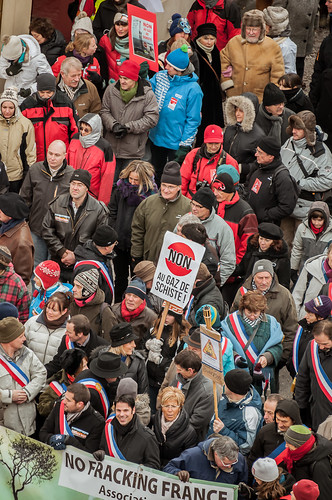John Dizard raises questions about US unconventional gas reserves
Q: Do you have any regrets?
A: Unconventional did not exactly play out as planned. (Peter Voser, retiring chief executive of Royal Dutch Shell)
Near outright admissions of error by chief executives, such as Mr Voser’s as quoted in the Financial Times, are far too rare, thanks to the bubbles of sycophancy in which most of them live.
The “unconventional” he referred to is the general term the hydrocarbon world gives to reserves of oil and gas from difficult to extract rocks such as shales, or very densely packed (“tight”) sandstones. These require techniques such as hydraulic fracturing, or “fracking”, extra capital and skilled labour.
That a company with the technical ability and cash of Shell would find production from fracked shale had not “play(ed) out as planned” should give pause to the investors and commentators who have become believers in the shale miracle.
Mr Voser commendably took responsibility in August for a $2.1bn writedown on the value of the company’s US shale assets – particularly since I also misestimated the productivity of some US unconventional gas reserves, although in a different direction.
I had thought, when the benchmark US Henry Hub gas price bottomed at the beginning of last year, that a decline in gas drilling forced by a shortage of exploration and production sector cash flows would result in a very rapid rise in price to cover the full cost of production.
Well, prices have risen, but not as fast as I imagined.
That is due to high production from two sources that increased at greater rates than most industry people – and I – expected: “associated” gas, from oil or gas-liquids directed drilling, and gas wells in the Marcellus Shale.
The Marcellus is a huge “play” of sedimentary rock across much of the northeastern US, with gas and liquids production concentrated in western Pennsylvania, Ohio and West Virginia. There are also a lot of Marcellus reserves in New York state, but there is effective political opposition to developing them.
Without new production from the Marcellus, US gas supplies would probably have declined since President Obama hailed the shale revolution in his January 2012 State of the Union address. From a technical point of view, the strength of Marcellus production has been driven by shallow depth and short lead times, along with the industry’s rapid productivity increases.
Even so, there are some reasonable questions that can be raised about the Marcellus miracle, setting aside any tightening of federal, state or local regulation of shale gas drilling.
To begin with, despite the extraordinary success of the exploration and production effort, not a lot of money is being made. Consider Cabot Oil and Gas, which has an excellent reputation for management, reserve quality and technical ability, especially in the Marcellus region.
Last year, it chalked up a return on equity of about 9.5 per cent.
That is good; if it were a European bank, COG would be at the head of the class, but it is not at the lighting-cigars-with-$100-bills end of capitalism.
As Mr Voser told the FT: “[Shale well] decline rates are very high, so after 18 months your production drops very sharply, which means you have a business model of constant investment.”
That is demanding enough for a highly diversified investment grade company such as Shell; if your company is junk-rated, it is much harder.
Also, rising Henry Hub prices overstate how much Marcellus producers have benefited from their hard work and good luck. Ryan Smith, an analyst at Bentek, an energy research firm that recently published a report on the Marcellus and Utica shale plays, points to the “basis”, or discount, that Marcellus gas is getting. “Producers are constrained by pipeline capacity, which is vital. When [one of two new pipelines comes on line] in November, that will be filled up within a month. Drilling is backlogged.”
Beyond next year, though, there is a steep wall of capital demands for new pipelines, reversals of existing pipelines, export terminals, nearby chemical plants, and gas-fired power plants.
What really surprised the industry was the continuing supply of new capital from lenders and return-short investors. This interrupted what would have been a typical oil and gas drilling cutback phase.
In other words, yes, there is a big Marcellus effect, but it may turn out to have been superhyped by quantitative easing. We will see what happens if the oil price falls and interest rates ever rise.
Well, prices have risen, but not as fast as I imagined.
That is due to high production from two sources that increased at greater rates than most industry people – and I – expected: “associated” gas, from oil or gas-liquids directed drilling, and gas wells in the Marcellus Shale.
The Marcellus is a huge “play” of sedimentary rock across much of the northeastern US, with gas and liquids production concentrated in western Pennsylvania, Ohio and West Virginia. There are also a lot of Marcellus reserves in New York state, but there is effective political opposition to developing them.
Without new production from the Marcellus, US gas supplies would probably have declined since President Obama hailed the shale revolution in his January 2012 State of the Union address. From a technical point of view, the strength of Marcellus production has been driven by shallow depth and short lead times, along with the industry’s rapid productivity increases.
Even so, there are some reasonable questions that can be raised about the Marcellus miracle, setting aside any tightening of federal, state or local regulation of shale gas drilling.
To begin with, despite the extraordinary success of the exploration and production effort, not a lot of money is being made. Consider Cabot Oil and Gas, which has an excellent reputation for management, reserve quality and technical ability, especially in the Marcellus region.
Last year, it chalked up a return on equity of about 9.5 per cent.
That is good; if it were a European bank, COG would be at the head of the class, but it is not at the lighting-cigars-with-$100-bills end of capitalism.
As Mr Voser told the FT: “[Shale well] decline rates are very high, so after 18 months your production drops very sharply, which means you have a business model of constant investment.”
That is demanding enough for a highly diversified investment grade company such as Shell; if your company is junk-rated, it is much harder.
Also, rising Henry Hub prices overstate how much Marcellus producers have benefited from their hard work and good luck. Ryan Smith, an analyst at Bentek, an energy research firm that recently published a report on the Marcellus and Utica shale plays, points to the “basis”, or discount, that Marcellus gas is getting. “Producers are constrained by pipeline capacity, which is vital. When [one of two new pipelines comes on line] in November, that will be filled up within a month. Drilling is backlogged.”
Beyond next year, though, there is a steep wall of capital demands for new pipelines, reversals of existing pipelines, export terminals, nearby chemical plants, and gas-fired power plants.
What really surprised the industry was the continuing supply of new capital from lenders and return-short investors. This interrupted what would have been a typical oil and gas drilling cutback phase.
In other words, yes, there is a big Marcellus effect, but it may turn out to have been superhyped by quantitative easing. We will see what happens if the oil price falls and interest rates ever rise.






Un comentariu:
vezi si:
dangerous exponentials
a radical take on the future
our core thesis
Dr Tim Morgan Global Head of Research
https://docs.google.com/file/d/0BwwGUY5dR5PnWW5VandVLUNUUUU/edit?usp=sharing
Trimiteți un comentariu